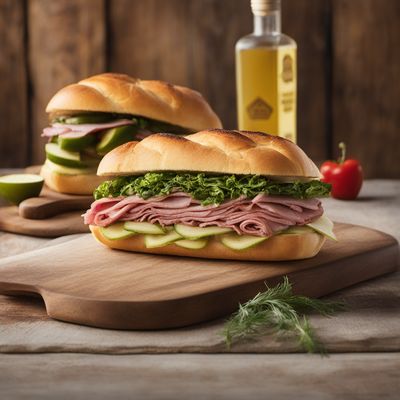
Ingredient
Cheese
The Dairy Delight
Cheese is a dairy product made from the curdled milk of cows, goats, or sheep. It comes in a variety of textures, from soft and creamy to hard and crumbly, and can be aged for different lengths of time, resulting in a wide range of flavors. Cheese is produced through a complex process that involves curdling the milk, separating the curds from the whey, and then pressing, salting, and aging the curds. The final product can vary greatly depending on the type of milk used, the production method, and the aging process. Cheese is used in a multitude of dishes, including sandwiches, pizzas, pasta, and desserts, and can be enjoyed on its own as a snack or appetizer.
Origins and history
The origins of cheese can be traced back thousands of years to various ancient civilizations, including those in Mesopotamia, Egypt, and Greece. It was initially developed as a way to preserve milk and make it more portable. Over time, cheese-making techniques spread throughout Europe, with different regions developing their own unique varieties and styles. Today, cheese is produced and enjoyed worldwide, with each country having its own traditional cheeses and cheese-making methods.
Nutritional information
Cheese is a good source of protein, calcium, and phosphorus. It also contains vitamins A and B12, as well as essential fatty acids. However, it is high in saturated fat and sodium, so it should be consumed in moderation as part of a balanced diet. The nutritional content of cheese can vary depending on the type and aging process.
Allergens
Some individuals may be allergic to certain types of cheese, particularly those with lactose intolerance or milk protein allergies. It is important to read labels and check for any potential allergens before consuming cheese.
How to select
When selecting cheese, consider the type of cheese you need for your recipe or desired flavor profile. Soft cheeses should be creamy and free from any signs of mold or excessive moisture. Hard cheeses should have a firm texture and a well-aged rind. Opt for cheese that is produced using high-quality milk and traditional cheese-making methods for the best flavor and quality.
Storage recommendations
To maintain the freshness and quality of cheese, it is important to store it properly. Most cheeses should be stored in the refrigerator, wrapped in wax paper or cheese paper to allow them to breathe. Hard cheeses can be stored for longer periods and may develop more flavor with age. Soft cheeses should be consumed within a few days of purchase for the best texture and flavor. Avoid storing cheese near strong-smelling foods, as it can absorb odors.
How to produce
Cheese production requires specialized equipment and knowledge, making it more suitable for commercial or artisanal production. However, some fresh cheeses, like ricotta or paneer, can be made at home using simple ingredients and techniques. There are many resources available online or in cookbooks that provide step-by-step instructions for making cheese at home.
Preparation tips
Cheese can be used in a wide range of dishes and cuisines. It can be melted, grated, sliced, or crumbled, depending on the desired application. Cheese is commonly used in sandwiches, pizzas, pasta dishes, and salads. It can also be enjoyed on its own or paired with fruits, nuts, or cured meats as part of a cheese board or charcuterie platter. The versatility of cheese allows it to be incorporated into both savory and sweet recipes, adding richness and depth of flavor.
Substitutions
There are no direct substitutions for cheese, as its unique flavor and texture cannot be replicated. However, there are dairy-free alternatives available for individuals with lactose intolerance or milk allergies. These alternatives are typically made from plant-based ingredients like nuts, soy, or coconut and can be used in similar ways to cheese.
Culinary uses
Cheese is a staple ingredient in many cuisines around the world. It is commonly used in European cuisines, such as Italian, French, and Swiss, where it is featured in dishes like pasta, fondue, and raclette. Cheese is also prevalent in American cuisine, particularly in dishes like burgers, macaroni and cheese, and grilled cheese sandwiches. It is cultivated and produced in many countries, with each region having its own unique varieties and styles of cheese.
Availability
Cheese is widely available in grocery stores, supermarkets, and specialty cheese shops around the world. The availability of specific types of cheese may vary depending on the region and local preferences.
More ingredients from this category

Cheese powder
The Magic of Cheesy Dust

Brined cheese (feta-type and similar)
The Tangy Delight: Brined Cheese

Cheese rind
The Flavorful Armor: Exploring the World of Cheese Rinds

Fresh uncured cheese
Creamy Delight: Exploring the World of Fresh Uncured Cheese

Ripened cheese
Aged Delights: The Art of Ripened Cheese

Processed cheese and spreads
Versatile Delights: Exploring Processed Cheese and Spreads
Recipes using Cheese » Browse all

Filipino Chinese Rice Burger
Savory Fusion: Filipino Chinese Rice Burger

Classic Reuben Corned Beef Sandwich
Savory Stacked Reuben: A Flavorful Twist on the Classic Corned Beef Sandwich

Cuban-Inspired Loaded Sandwich
The Ultimate Cuban Sandwich: A Flavorful Delight

Vietnamese-style Cordon Bleu
Banh Mi Cordon Bleu: A Fusion of Swiss and Vietnamese Flavors

Refreshing Jellyfish Salad
Ocean Delight: A Vibrant Jellyfish Salad

Juicy Lucy Stuffed Burger
Cheesy Surprise Burger

German Semmelwrap
Savory German Bread Roll Wrap

Russian-style Chicken Cordon Bleu
Borscht-inspired Chicken Cordon Bleu: A Russian Twist on a Classic Dish

Cuban Cordon Bleu
Havana Ham and Cheese Delight

Soulful Cordon Bleu
Soulful Stuffed Chicken with Ham and Cheese

Nom Lote with Lemongrass Grilled Chicken
Lemongrass Infused Nom Lote: A Cambodian Delight

Luther Burger
Indulgent Bacon-Infused Burger Delight